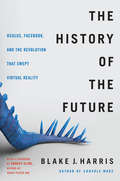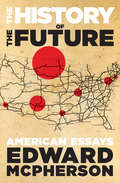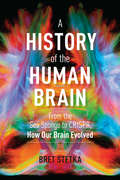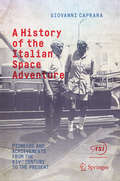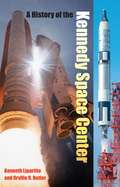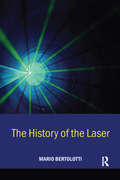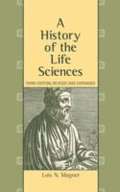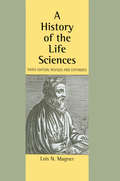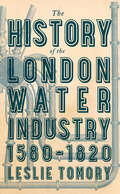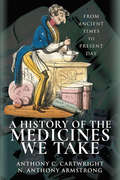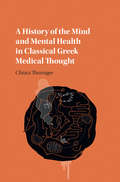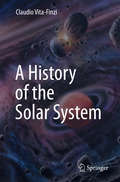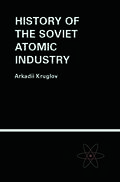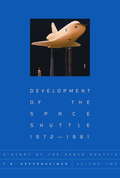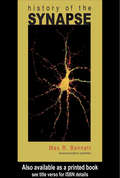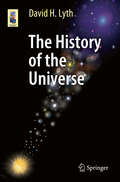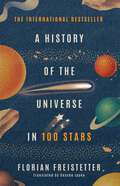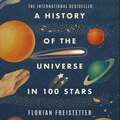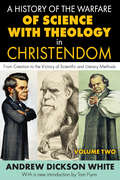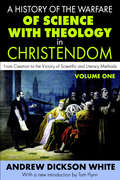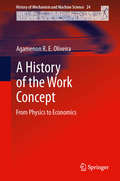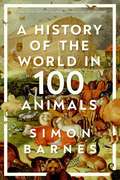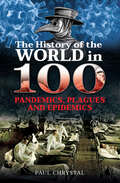- Table View
- List View
The History of the Future: Oculus, Facebook, and the Revolution That Swept Virtual Reality
by Blake J. HarrisThe author of Console Wars reveals the story behind Oculus and its quest for virtual reality: “Masterful . . . filled with unforgettable characters” (Forbes).From iconic books like Neuromancer to blockbuster films like The Matrix, virtual reality has offered a tantalizing vision of the future. But outside of a few research labs and military training facilities, this technology was mere science fiction. Until 2012, when Oculus founder Palmer Luckey—then just a teenage dreamer living alone in a camper trailer—invents a device that has the potential to change the world.With the help of a videogame legend, a serial entrepreneur, and many other colorful characters, Luckey’s scrappy startup kickstarts a revolution and sets out to bring VR to the masses. What follows is the ultimate entrepreneurial journey, a tale of battles won and lost, lessons learned and shocking turns—including an unlikely multi-billion-dollar acquisition by Facebook’s Mark Zuckerberg.Drawing on over a hundred interviews with the key players driving this revolution, The History of the Future weaves together a rich, cinematic narrative that captures the breakthroughs, breakdowns, and human drama of trying to change the world. The result is a supremely entertaining look at the birth of a game-changing new industry.
The History of the Future: American Essays
by Edward McphersonWhat does it mean to think about Dallas in relationship to Dallas? In The History of the Future, McPherson reexamines American places and the space between history, experience, and myth. Private streets, racism, and the St. Louis World’s Fair; fracking for oil and digging for dinosaurs in North Dakota boomtowns-Americana slides into apocalypse in these essays, revealing us to ourselves.
A History of the Human Brain: From the Sea Sponge to CRISPR, How Our Brain Evolved
by Bret Stetka&“A History of the Human Brain is a unique, enlightening, and provocative account of the most significant question we can ask about ourselves.&” —Richard Wrangham, author of The Goodness Paradox Just 125,000 years ago, humanity was on a path to extinction, until a dramatic shift occurred. We used our mental abilities to navigate new terrain and changing climates. We hunted, foraged, tracked tides, shucked oysters—anything we could do to survive. Before long, our species had pulled itself back from the brink and was on more stable ground. What saved us? The human brain—and its evolutionary journey is unlike any other. In A History of the Human Brain, Bret Stetka takes us on this far-reaching journey, explaining exactly how our most mysterious organ developed. From the brain&’s improbable, watery beginnings to the marvel that sits in the head of Home sapiens today, Stetka covers an astonishing progression, even tackling future brainy frontiers such as epigenetics and CRISPR. Clearly and expertly told, this intriguing account is the story of who we are. By examining the history of the brain, we can begin to piece together what it truly means to be human.
A History of the Italian Space Adventure: Pioneers and Achievements from the XIVth Century to the Present
by Giovanni CapraraThis well-documented and fascinating book tells how, over the centuries, a series of visionaries, scientists, technologists, and politicians fostered the involvement of Italy in space exploration. The lives of these pioneers was often far from easy, yet they persevered. The fruits of their efforts can today be witnessed in Italy’s success within the cutting-edge space sector. Italy’s history in space started at the end of the fourteenth century and continued with the development of fireworks. Later, the nineteenth century marked the beginning of research into rockets in a more scientific way. After World War II, rocket technology was advanced with the aid of German scientists, and in the 1960s Luigi Broglio, the father of Italian space exploration, designed the San Marco satellite. In 1979 the first Italian Space Plan was launched, but it was the foundation of the Italian Space Agency in 1988 that kick-started a program of exploration in various fields of cosmic research. The outcome was construction of the Vega launcher and collaboration in the International Space Station. Now the Italian space industry stands ready to play an important role in the Gateway orbital station. All of this history, and more, is explored in this riveting book.
A History of the Kennedy Space Center
by Kenneth Lipartito Orville ButlerThis first comprehensive history of the Kennedy Space Center, NASA's famous launch facility located at Cape Canaveral, Florida, reveals the vital but largely unknown work that takes place before the rocket is lit. Though the famous Vehicle Assembly Building and launch pads dominate the flat Florida landscape at Cape Canaveral and attract 1.5 million people each year to its visitor complex, few members of the public are privy to what goes on there beyond the final outcome of the flaring rocket as it lifts into space. With unprecedented access to a wide variety of sources, including the KSC archives, other NASA centers, the National Archives, and individual and group interviews and collections, Lipartito and Butler explore how the methods and technology for preparing, testing, and launching spacecraft have evolved over the last 45 years. Their story includes the Mercury and Gemini missions, the Apollo lunar program, the Space Shuttle, scientific missions and robotic spacecraft, and the International Space Station, as well as the tragic accidents of Challenger and Columbia. Throughout, the authors reveal the unique culture of the people who work at KSC and make Kennedy distinct from other parts of NASA.
The History of the Laser
by Mario BertolottiSince the invention of the first working laser in 1960, development of these devices has progressed at an unprecedented rate, to the extent that the laser is now a common part of everyday life, from the semiconductor laser used in CD players and telecommunication systems to the high power eximer lasers used in manufacturing processes. This book tra
A History of the Life Sciences
by Lois N. MagnerA clear and concise survey of the major themes and theories embedded in the history of life science, this book covers the development and significance of scientific methodologies, the relationship between science and society, and the diverse ideologies and current paradigms affecting the evolution and progression of biological studies. The author discusses cell theory, embryology, physiology, microbiology, evolution, genetics, and molecular biology; the Human Genome Project; and genomics and proteomics. Covering the philosophies of ancient civilizations to modern advances in genomics and molecular biology, the book is a unique and comprehensive resource.
A History of the Life Sciences, Revised and Expanded
by Lois N. MagnerA clear and concise survey of the major themes and theories embedded in the history of life science, this book covers the development and significance of scientific methodologies, the relationship between science and society, and the diverse ideologies and current paradigms affecting the evolution and progression of biological studies. The author d
The History of the London Water Industry, 1580–1820
by Leslie TomoryHow did pre-industrial London build the biggest water supply industry on earth?Beginning in 1580, a number of competing London companies sold water directly to consumers through a large network of wooden mains in the expanding metropolis. This new water industry flourished throughout the 1600s, eventually expanding to serve tens of thousands of homes. By the late eighteenth century, more than 80 percent of the city’s houses had water connections—making London the best-served metropolis in the world while demonstrating that it was legally, commercially, and technologically possible to run an infrastructure network within the largest city on earth.In this richly detailed book, historian Leslie Tomory shows how new technologies imported from the Continent, including waterwheel-driven piston pumps, spurred the rapid growth of London’s water industry. The business was further sustained by an explosion in consumer demand, particularly in the city’s wealthy West End. Meanwhile, several key local innovations reshaped the industry by enlarging the size of the supply network. By 1800, the success of London’s water industry made it a model for other cities in Europe and beyond as they began to build their own water networks. The city’s water infrastructure even inspired builders of other large-scale urban projects, including gas and sewage supply networks.The History of the London Water Industry, 1580–1820 explores the technological, cultural, and mercantile factors that created and sustained this remarkable industry. Tomory examines how the joint-stock form became popular with water companies, providing a stable legal structure that allowed for expansion. He also explains how the roots of the London water industry’s divergence from the Continent and even from other British cities was rooted both in the size of London as a market and in the late seventeenth-century consumer revolution. This fascinating and unique study of essential utilities in the early modern period will interest business historians and historians of science and technology alike.
A History of the Medicines We Take: From Ancient Times to Present Day
by Anthony C. Cartwright N Anthony ArmstrongA fascinating account of poultices, pills, and prescriptions over the centuries and how they’ve been developed and delivered.This lively account follows the development of medicines from traces of herbs found with the remains of Neanderthal man, to prescriptions written on clay tablets from Mesopotamia in the third millennium BC, to pure drugs extracted from plants in the nineteenth century, and to the latest biotechnology antibody products. In addition, it tells the stories behind historical figures in medicine, such as Christopher Wren, who gave the first intravenous injection in 1656, and William Brockedon, who invented the tablet in 1843, as well as recounting the changes in patterns of prescribing from simple dosage forms—such as liquid mixtures, pills, ointments, lotions, poultices, powders for treating wounds, inhalations, eye drops, enemas, pessaries, and suppositories mentioned in the Egyptian Ebers papyrus of 1550 BCE—to the complex tablets, injections, and inhalers in current use. A typical pharmacy now dispenses about as many prescriptions in a working day as a mid-nineteenth-century chemist did in a whole year. This history sheds light on the scientific progress made over centuries that led to the medical miracles of the modern world.
A History of the Mind and Mental Health in Classical Greek Medical Thought
by Chiara ThumigerThe Hippocratic texts and other contemporary medical sources have often been overlooked in discussions of ancient psychology. They have been considered to be more mechanical and less detailed than poetic and philosophical representations, as well as later medical texts such as those of Galen. This book does justice to these early medical accounts by demonstrating their richness and sophistication, their many connections with other contemporary cultural products and the indebtedness of later medicine to their observations. In addition, it reads these sources not only as archaeological documents but also in the light of methodological discussions that are fundamental to the histories of psychiatry and psychology. As a result of this approach, the book will be important for scholars of these disciplines as well as those of Greek literature and philosophy, strongly advocating the relevance of ancient ideas to modern debates.
History of the Plurality of Worlds: The Myths of Extraterrestrials Through the Ages (Historical & Cultural Astronomy)
by Pierre ConnesModern research has demonstrated that many stars are surrounded by planets—some of which might contain the right conditions to harbor life. This has only reinforced a question that has been tormenting scientists, philosophers and priests since Antiquity: Are there other inhabited worlds beyond our own?This book analyzes the many ways that humans have argued for and depicted extraterrestrial life over the centuries. The first known texts about the subject date from as early as the 6th century BC. Since that time, countless well-known historical characters like Lucretius, Aristotle, Thomas Aquinas, Cusanus, Bruno, Kepler, Descartes, and Huygens contributed to the debate; here, their lesser known opinions on the subject are studied in detail.It is often difficult for the modern mind to follow the thinking of our ancestors, which can only be understood when placed in the relevant context. The book thus extends its scope to the evolution of ideas about cosmology in general, as well as the culture in which these great thinkers wrote. The research is presented with the author's insights and humor, making this an easy and enjoyable read.
A History of the Solar System
by Claudio Vita-FinziThis well illustrated book presents a compact history of the Solar System from its dusty origins 4,600,000 years ago to the present day. Its primary aim is to show how the planets and their satellites, comets, meteors, interplanetary dust, solar radiation and cosmic rays continually interact, sometimes violently, and it reflects humanity's progress in exploring and interpreting this history. The book is intended for a general readership at a time when human and robotic exploration of space is often in the news and should also appeal to students at all levels. It covers the essentials but refers to a large literature which can be accessed via the internet.
The History of the Soviet Atomic Industry
by Arkadii KruglovFor the first time, readers can discover the numerous pioneers of the Soviet nuclear industry, including the role of scientific supervisors of Russia's nuclear project and the statesmen who coordinated the function of the atomic industry in the former USSR. This is a detailed account, translated to English for the first time, of the development of
History of the Space Shuttle, Volume Two
by T. A. HeppenheimerBasing his work on virtually untapped NASA archives, T. A. Heppenheimer has produced the second volume of his definitive history of the space shuttle. Volume Two traces the development of the shuttle through a decade of engineering setbacks and breakthroughs, program-management challenges, and political strategizing, culminating in the first launch in April 1981. The focus is on the engineering challenges--propulsion, thermal protection, electronics, onboard systems--and the author covers in depth the alternative vehicles developed by the U.S. Air Force and European countries. The first launch entailed a monumental amount of planning and preparation that Heppenheimer explains in detail.
History of the Synapse
by Max R. BennettThe History of the Synapse provides a history of those discoveries concerning the identification and function of synapses that provide the foundations for research during this new century with a personal view of the process by which new concepts have developed. Previously published as essays, the chapters in this book provide a history of various a
The History of the Universe
by David H. LythThis book gives an accessible account of the history of the Universe; not only what happened, but why it happened. An author of textbooks on the early Universe and inflation, David Lyth now explains both cosmology and the underlying physics to the general reader. The book includes a detailed account of the almost imperceptible structure in the early Universe, and its probable origin as a quantum fluctuation during an early epoch known as the epoch of inflation. It also explains how that early structure is visible now in the cosmic microwave radiation which is our main source of information about the early Universe, and how it gave rise to galaxies and stars. The main text of the book assumes no knowledge of mathematics or physics so that it is accessible to everybody, while an appendix contains more advanced material. As a result the book will be useful for a wide spectrum of readers, including high-school students, undergraduates, postgraduates and professional physicists working in areas other than cosmology. It will also serve as "additional reading" for university courses in general astronomy, astrophysics or cosmology itself.
A History of the Universe in 100 Stars
by Florian Freistetter'Inventive [...] done beautifully' - TLSFrom the Big Bang to the Gaia Mission, this is a very personal history of the universe through the author's favourite 100 stars.Astronomer Florian Freistetter has chosen 100 stars that have almost nothing in common. Some are bright and famous, some shine so feebly you need a huge telescope. There are big stars, small stars, nearby stars and faraway stars. Some died a while ago, others have not even yet come into being. Collectively they tell the story of the whole world, according to Freistetter. There is Algol, for example, the Demon Star, whose strange behaviour has long caused people sleepless nights. And Gamma Draconis, from which we know that the earth rotates around its own axis. There is also the star sequence 61 Cygni, which revealed the size of the cosmos to us.Then there are certain stars used by astronomers to search for extra-terrestrial life, to explore interstellar space travel, or to explain why the dinosaurs became extinct.In 100 short, fascinating and entertaining chapters, Freistetter not only reveals the past and future of the cosmos, but also the story of the people who have tried to understand the world in which we live.
A History of the Universe in 100 Stars
by Florian FreistetterFrom the Big Bang to the Gaia Mission, this is a very personal history of the universe through the author's favourite 100 stars.Astronomer Florian Freistetter has chosen 100 stars that have almost nothing in common. Some are bright and famous, some shine so feebly you need a huge telescope. There are big stars, small stars, nearby stars and faraway stars. Some died a while ago, others have not even yet come into being. Collectively they tell the story of the whole world, according to Freistetter. There is Algol, for example, the Demon Star, whose strange behaviour has long caused people sleepless nights. And Gamma Draconis, from which we know that the earth rotates around its own axis. There is also the star sequence 61 Cygni, which revealed the size of the cosmos to us.Then there are certain stars used by astronomers to search for extra-terrestrial life, to explore interstellar space travel, or to explain why the dinosaurs became extinct.In 100 short, fascinating and entertaining chapters, Freistetter not only reveals the past and future of the cosmos, but also the story of the people who have tried to understand the world in which we live.(P)2021 Quercus Editions Limited
A History of the Warfare of Science with Theology in Christendom: Volume 2, From Creation to the Victory of Scientific and Literary Methods
by J.M. CohenGiven the powerful and forthright title of Andrew Dickson White's classic study, it is best to make clear his own sense of the whole as given in the original 1896 edition: "My conviction is that science, though it has evidently conquered dogmatic theology based on biblical texts and ancient modes of thought, will go hand in hand with religion, and that although theological control will continue to diminish, religion as seen in the recognition of a 'power in the universe, not ourselves, which makes for righteousness' and in the love of God and of our neighbor, will steadily grow stronger and stronger, not only in the American institutions of learning, but in the world at large." White began to assemble his magnum opus, a two volume work first published in 1896 as A History of the Warfare of Science with Theology in Christendom. In correspondence he wrote that he intended the work to stake out a position between such religious orthodoxy as John Henry Newman's on one side and such secular scoffing as Robert Ingersoll's on the other. Historian Paul Carter declared that this book did as much as any other published work "toward routing orthodoxy in the name of science." Insofar as science and religion came to be widely viewed as enemies, with science holding the moral high ground, White inadvertently, became one of the most effective and influential advocates for unbelief.
A History of the Warfare of Science with Theology in Christendom: Volume 1, From Creation to the Victory of Scientific and Literary Methods
by Andrew WhiteGiven the powerful and forthright title of Andrew Dickson White's classic study, it is best to make clear his own sense of the whole as given in the original 1896 edition: "My conviction is that science, though it has evidently conquered dogmatic theology based on biblical texts and ancient modes of thought, will go hand in hand with religion, and that although theological control will continue to diminish, religion as seen in the recognition of a 'power in the universe, not ourselves, which makes for righteousness' and in the love of God and of our neighbor, will steadily grow stronger and stronger, not only in the American institutions of learning, but in the world at large." White began to assemble his magnum opus, a two volume work first published in 1896 as A History of the Warfare of Science with Theology in Christendom. In correspondence he wrote that he intended the work to stake out a position between such religious orthodoxy as John Henry Newman's on one side and such secular scoffing as Robert Ingersoll's on the other. Historian Paul Carter declared that this book did as much as any other published work "toward routing orthodoxy in the name of science." Insofar as science and religion came to be widely viewed as enemies, with science holding the moral high ground, White inadvertently, became one of the most effective and influential advocates for unbelief.
History of the Warfare of Science with Theology in Christendom
by Andrew Dickson WhiteWallpaper* City Guidesnot only suggest where to stay, what to eat, and what to drink, but what the tourist passionate about design might want to see, whether he or she has a week or just 24 hours in the city. <P> <P> Some of the highlights include up-and-coming neighborhoods, an `Architour? of landmark buildings, design centers, and the best shops to buy unique items. Wallpaper* City Guidespresent travelers with a fast-track ticket to the chosen location. The tightly-edited guides offer the best, most exciting, and the most beautiful of the featured city. The guides are expertly designed with function as a priority, and they have tabbed sections so that readers can find information easily. The guides include currency rate information, maps, and a color-coding system to help the reader navigate through different parts of the city. They are the ultimate combination of form and function. The guides are compiled byWallpaper*magazine experts and their extraordinary network of international correspondents. The writers have put their heads together to come up with fascinating, efficient guides for the hip, urban traveler with his or her finger on the pulse. They are truly the insider's guide to each featured city. The firstWallpaper* City Guideswere published in Fall 2006 on the occasion ofWallpaper*?sfirst anniversary. For more than a decade,Wallpaper*has been the first to uncover and enticingly present the best urban travel spots from across the globe. The City Guides are the perfect way to present a decade of experience in one precisely edited guide. As of early 2010, there are 80 city guides available, with seven more on the way by the end of the year.
A History of the Work Concept: From Physics to Economics (History of Mechanism and Machine Science #24)
by Agamenon R. E. OliveiraThis book traces the history of the concept of work from its earliest stages and shows that its further formalization leads to equilibrium principle and to the principle of virtual works, and so pointing the way ahead for future research and applications. The idea that something remains constant in a machine operation is very old and has been expressed by many mathematicians and philosophers such as, for instance, Aristotle. Thus, a concept of energy developed. Another important idea in machine operation is Archimedes' lever principle. In modern times the concept of work is analyzed in the context of applied mechanics mainly in Lazare Carnot mechanics and the mechanics of the new generation of polytechnical engineers like Navier, Coriolis and Poncelet. In this context the word "work" is finally adopted. These engineers are also responsible for the incorporation of the concept of work into the discipline of economics when they endeavoured to combine the study of the work of machines and men together.
A History of the World in 100 Animals
by Simon BarnesFully illustrated in color, a fascinating exploration of the one hundred animals that have had the most profound influence on humanity throughout the ages.We are not alone. We are not alone on the planet. We are not alone in the countryside. We are not alone in cities. We are not alone in our homes. We are humans and we love the idea of our uniqueness. But the fact is that we humans are as much members of the animal kingdom as the cats and dogs we surround ourselves with, the cows and the fish we eat, and the bees who pollinate so many of our food-plants. In The History of the World in 100 Animals, award-winning author Simon Barnes selects the one hundred animals who have had the greatest impact on humanity and on whom humanity has had the greatest effect. He shows how we have domesticated animals for food and for transport, and how animals powered agriculture, making civilisation possible. A species of flea came close to destroying human civilisation in Europe, while the slaughter of a species of bovines was used to create one civilisation and destroy another. He explains how pigeons made possible the biggest single breakthrough in the history of human thought. In short, he charts the close relationship between humans and animals, finding examples from around the planet that bring the story of life on earth vividly to life, with great insight and understanding. The heresy of human uniqueness has led us across the millennia along the path of destruction. This book, beautifully illustrated throughout, helps us to understand our place in the world better, so that we might do a better job of looking after it. That might save the polar bears, the modern emblem of impending loss and destruction. It might even save ourselves.
The History of the World in 100 Pandemics, Plagues and Epidemics
by Paul ChrystalThis &“timely, topical, informative [and] exceptionally well written&” history explores the impact of disease from prehistoric plagues to Covid-19 (Midwest Book Review). Historian Paul Chrystal charts how human civilization has grappled with successive pandemics, plagues, and epidemics across millennia. Ranging from prehistory to the present day, this volume begins by defining what constitutes a pandemic or epidemic, taking a close look at 20 historic examples: including cholera, influenza, bubonic plague, leprosy, measles, smallpox, malaria, AIDS, MERS, SARS, Zika, Ebola and, of course, Covid-19. Some less well-known, but equally significant and deadly contagions such as Legionnaires&’ Disease, psittacosis, polio, the Sweat, and dancing plague, are also covered. Chrystal provides comprehensive information on each disease, including epidemiology, sources and vectors, morbidity, and mortality, as well as governmental and societal responses, and their political, legal, and scientific consequences. He sheds light on how public health crises have shaped history—particularly in the realms of medical and scientific research and vaccine development. Chrystal also examines myths about infectious diseases, and the role of the media, including social media.
